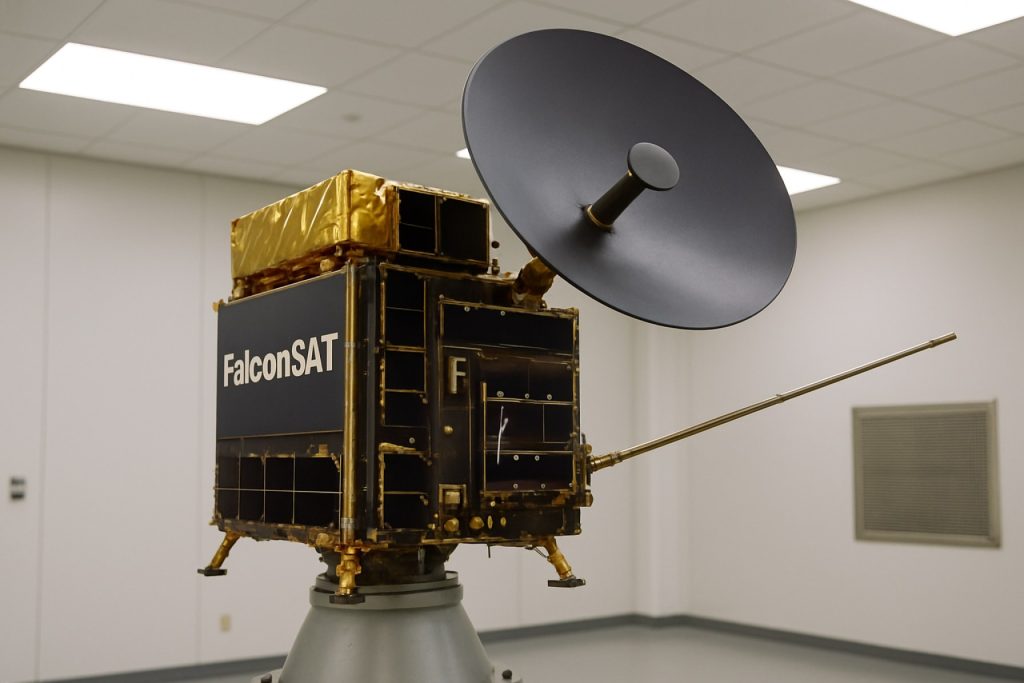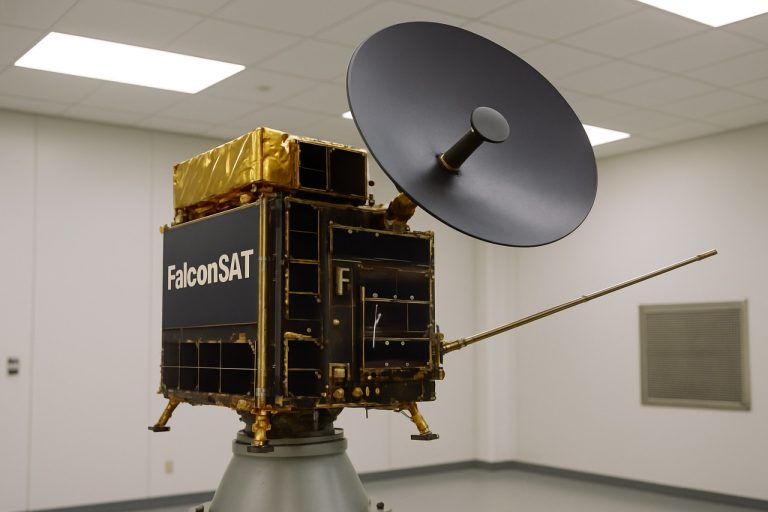
Inside FalconSAT: How the U.S. Air Force Academy’s Satellite Initiative is Shaping the Future of Space Technology. Discover the Missions, Innovations, and Impact of FalconSAT’s Trailblazing Projects.
- Introduction to FalconSAT: Origins and Objectives
- Key Missions and Milestones of FalconSAT
- Technological Innovations and Payloads
- Role of the U.S. Air Force Academy in FalconSAT
- Educational Impact and Student Involvement
- Collaborations and Partnerships
- Challenges Faced and Lessons Learned
- Future Directions and Upcoming Launches
- FalconSAT’s Influence on Military and Civilian Space Operations
- Sources & References
Introduction to FalconSAT: Origins and Objectives
FalconSAT is a series of small satellites developed and operated by the United States Air Force Academy (USAFA) as part of its cadet space research and education program. Initiated in the late 1990s, the FalconSAT program was designed to provide hands-on experience in satellite engineering, mission planning, and space operations for cadets, while also contributing to the advancement of small satellite technologies. The program’s origins can be traced to the USAFA’s commitment to integrating practical aerospace projects into its academic curriculum, fostering innovation and technical expertise among future Air Force officers.
The primary objectives of FalconSAT are twofold: to serve as an educational platform for cadets and to conduct scientific and technological experiments in space. Each FalconSAT mission is typically developed by undergraduate students under faculty supervision, encompassing all phases from design and assembly to testing and operations. These missions often focus on investigating new space technologies, such as advanced communication systems, attitude control mechanisms, and novel sensor payloads. By doing so, FalconSAT not only enhances the learning experience for cadets but also supports the Air Force’s broader goals of technological advancement and operational readiness in the space domain.
Over the years, FalconSAT has launched multiple satellites, each with unique experimental payloads and mission profiles. The program’s collaborative approach, involving partnerships with organizations such as the Air Force Research Laboratory and NASA, has further expanded its impact and relevance within the aerospace community (United States Air Force Academy).
Key Missions and Milestones of FalconSAT
The FalconSAT program, developed by the U.S. Air Force Academy, has achieved several key missions and milestones since its inception in the late 1990s. Each FalconSAT satellite is designed and built by cadets, providing hands-on experience in satellite engineering and operations. The program’s first major milestone was the launch of FalconSAT-1 in 2000, which, despite a power system failure shortly after reaching orbit, marked a significant achievement in student-led satellite development.
Subsequent missions built on these early lessons. FalconSAT-2 was lost in the 2006 Falcon 1 launch failure, but the program rebounded with FalconSAT-3 in 2007. FalconSAT-3 successfully conducted ionospheric research and served as an educational platform for over a decade, becoming a testbed for amateur radio and satellite operations. FalconSAT-5, launched in 2010, carried advanced plasma sensors and contributed valuable data to space weather research.
A notable milestone was the launch of FalconSAT-6 in 2018, which featured a modular bus design and hosted multiple experiments, including propulsion and communications payloads. Each mission has advanced the technical capabilities of the program and provided invaluable real-world training for cadets. The FalconSAT program’s iterative approach, learning from both successes and setbacks, has established it as a cornerstone of undergraduate space education and a contributor to small satellite research and innovation within the U.S. Air Force and beyond.
Technological Innovations and Payloads
FalconSAT satellites have served as a platform for a range of technological innovations and experimental payloads, primarily developed and operated by cadets at the United States Air Force Academy. Each FalconSAT mission has been designed to test and validate new space technologies, contributing to both educational objectives and the advancement of small satellite capabilities. For example, United States Air Force Academy reports that FalconSAT-3 carried five experimental payloads, including a plasma sensor suite and a micro-propulsion system, to study ionospheric phenomena and demonstrate advanced attitude control techniques.
Subsequent missions, such as FalconSAT-5 and FalconSAT-6, have continued this tradition of innovation. FalconSAT-5 tested a novel propulsion system and advanced communications payloads, while FalconSAT-6 included experiments in electric propulsion, solar array deployment, and space situational awareness. These missions have provided valuable data for the development of future Department of Defense and commercial satellite technologies. The modular design of FalconSAT buses allows for rapid integration of new payloads, making them ideal for iterative testing and technology maturation in orbit.
Additionally, FalconSAT missions have contributed to the development of miniaturized sensors, improved onboard data processing, and autonomous operations. The program’s emphasis on hands-on cadet involvement ensures that each mission not only advances technology but also trains the next generation of space engineers and operators. The cumulative impact of these innovations is evident in the growing sophistication and reliability of small satellite platforms used across the U.S. military and allied space programs (Air Force Research Laboratory).
Role of the U.S. Air Force Academy in FalconSAT
The U.S. Air Force Academy (USAFA) plays a central and multifaceted role in the FalconSAT program, serving as both the primary developer and educational facilitator. FalconSAT is an ongoing series of small satellite missions designed, built, tested, and operated by cadets at the Academy, under the guidance of faculty and in collaboration with various government and industry partners. The program is housed within the Department of Astronautics, which integrates FalconSAT projects into the academic curriculum, providing cadets with invaluable hands-on experience in spacecraft engineering, systems integration, and mission operations. This experiential learning environment allows cadets to apply theoretical knowledge from their coursework to real-world aerospace challenges, fostering skills in teamwork, project management, and problem-solving.
USAFA’s involvement extends beyond education; it also contributes to advancing small satellite technology and supporting Department of Defense research objectives. Through FalconSAT, cadets have the opportunity to work on cutting-edge payloads and technologies, some of which are later adopted for operational use or further research. The Academy’s unique position as both an educational institution and a military organization enables it to bridge the gap between academic research and national security needs. The program’s success is evidenced by multiple successful satellite launches and operational missions, which have provided valuable data and training for future Air Force officers. For more information, visit the U.S. Air Force Academy and the U.S. Air Force official websites.
Educational Impact and Student Involvement
FalconSAT has played a pivotal role in advancing hands-on aerospace education, particularly at the United States Air Force Academy (USAFA). The program is designed to immerse cadets in the full lifecycle of satellite missions, from initial concept and design to integration, testing, launch, and on-orbit operations. This experiential learning model provides students with invaluable real-world engineering experience, bridging the gap between theoretical coursework and practical application. Cadets are responsible for critical mission elements, including systems engineering, payload development, and mission operations, fostering teamwork, leadership, and problem-solving skills.
The educational impact of FalconSAT extends beyond technical proficiency. By engaging in authentic space missions, students gain exposure to project management, risk assessment, and interdisciplinary collaboration, all under the mentorship of faculty and industry partners. This approach has produced graduates who are exceptionally well-prepared for careers in the U.S. Space Force, Air Force, and the broader aerospace sector. The program’s success is reflected in its alumni, many of whom have gone on to lead significant space initiatives and contribute to national security and scientific advancement.
FalconSAT’s model has also inspired similar educational satellite programs at other institutions, highlighting its influence on STEM education nationwide. The program’s ongoing evolution ensures that cadets continue to work with cutting-edge technologies and contemporary mission challenges, maintaining its status as a benchmark for experiential learning in aerospace engineering (United States Air Force Academy).
Collaborations and Partnerships
FalconSAT’s development and operational success have been significantly shaped by a network of collaborations and partnerships spanning government agencies, academic institutions, and private industry. The United States Air Force Academy (USAFA) leads the program, but it has consistently partnered with organizations such as the Air Force Research Laboratory (AFRL), which provides technical expertise, payloads, and funding for research missions. These collaborations enable cadets to work on real-world space challenges and contribute to national defense objectives.
FalconSAT missions have also benefited from partnerships with NASA, particularly through the NASA Human Exploration and Operations Mission Directorate, which has provided launch opportunities and technical support. Such cooperation allows FalconSAT satellites to be launched as secondary payloads on NASA missions, reducing costs and increasing launch frequency.
Academic partnerships are another cornerstone of the program. The USAFA has worked with universities such as the University of Colorado Boulder and the Massachusetts Institute of Technology to share research, develop payloads, and advance satellite technology. These collaborations foster innovation and provide cadets with exposure to cutting-edge research and diverse technical perspectives.
Additionally, FalconSAT has engaged with private aerospace companies for component manufacturing, testing, and launch services. These industry partnerships ensure access to the latest commercial technologies and practices, further enhancing the educational and operational value of the program.
Challenges Faced and Lessons Learned
The FalconSAT program, developed by the United States Air Force Academy, has encountered a range of technical and operational challenges throughout its history, each providing valuable lessons for future small satellite missions. One of the primary challenges has been the integration of advanced payloads within the strict size, weight, and power constraints of CubeSat-class platforms. For example, FalconSAT-3 experienced issues with its attitude determination and control system, which affected its ability to maintain proper orientation in orbit. This highlighted the importance of rigorous ground testing and redundancy in critical subsystems (United States Air Force Academy).
Another significant challenge has been the management of limited resources, both in terms of funding and the availability of experienced personnel. As a student-led program, FalconSAT relies heavily on cadet involvement, which can lead to steep learning curves and occasional design oversights. The program has addressed this by fostering close mentorship between faculty and students, and by emphasizing iterative design processes that allow for incremental improvements across successive missions (U.S. Air Force).
Lessons learned from FalconSAT missions have influenced not only the Academy’s curriculum but also the broader small satellite community. Emphasis on robust systems engineering, comprehensive pre-flight testing, and clear documentation has become standard practice. These experiences underscore the value of hands-on education in preparing the next generation of aerospace engineers and have contributed to the ongoing evolution of small satellite design and operations (NASA).
Future Directions and Upcoming Launches
The FalconSAT program, operated by the United States Air Force Academy, continues to evolve as a platform for hands-on cadet education and innovative small satellite research. Looking ahead, future directions for FalconSAT emphasize the integration of advanced technologies such as miniaturized propulsion systems, improved attitude control, and enhanced onboard processing capabilities. These advancements aim to increase the scientific and operational utility of each mission, allowing for more complex experiments and real-time data analysis in orbit.
Upcoming launches are expected to build on the legacy of previous missions, with FalconSAT-8, launched in 2021, serving as a testbed for new technologies including electromagnetic propulsion and advanced communications payloads. The program is actively developing FalconSAT-9 and subsequent missions, which are anticipated to focus on space situational awareness, autonomous operations, and inter-satellite networking. These initiatives align with the broader goals of the U.S. Space Force and Department of Defense to enhance resilience and responsiveness in space operations.
Collaboration with industry partners and other academic institutions is also a key component of FalconSAT’s future. By leveraging commercial off-the-shelf components and fostering joint research, the program aims to accelerate innovation while maintaining cost-effectiveness. The continued support from the United States Air Force Academy and integration with national space strategies ensure that FalconSAT remains at the forefront of small satellite development and cadet education for years to come.
FalconSAT’s Influence on Military and Civilian Space Operations
FalconSAT, a series of small satellites developed by the United States Air Force Academy, has had a significant impact on both military and civilian space operations. Originally conceived as an educational platform for cadets, FalconSAT missions have evolved to serve as testbeds for advanced space technologies, contributing to the broader objectives of the U.S. Department of Defense and the commercial space sector. Through its various missions, FalconSAT has enabled the rapid prototyping and demonstration of new satellite subsystems, such as propulsion, communications, and attitude control, which are critical for both defense and commercial applications.
In the military domain, FalconSAT has provided the U.S. Air Force with valuable data on space situational awareness, satellite resilience, and the operational utility of small satellites in contested environments. These insights have informed the development of more robust and agile space architectures, supporting the shift toward proliferated low Earth orbit (LEO) constellations for enhanced national security. For example, FalconSAT-6 tested advanced propulsion and communication systems that are now being considered for integration into future military satellite constellations (United States Air Force).
On the civilian side, FalconSAT’s open data policies and collaborative research initiatives have fostered partnerships with universities and industry, accelerating innovation in satellite technology. The program’s emphasis on hands-on learning and real-world experimentation has also contributed to workforce development in the aerospace sector, supplying skilled engineers and scientists to both government and private space enterprises (United States Air Force Academy). Thus, FalconSAT serves as a bridge between military requirements and civilian advancements, shaping the future of space operations across domains.
Sources & References
- United States Air Force Academy
- NASA Human Exploration and Operations Mission Directorate
- University of Colorado Boulder
- Massachusetts Institute of Technology



